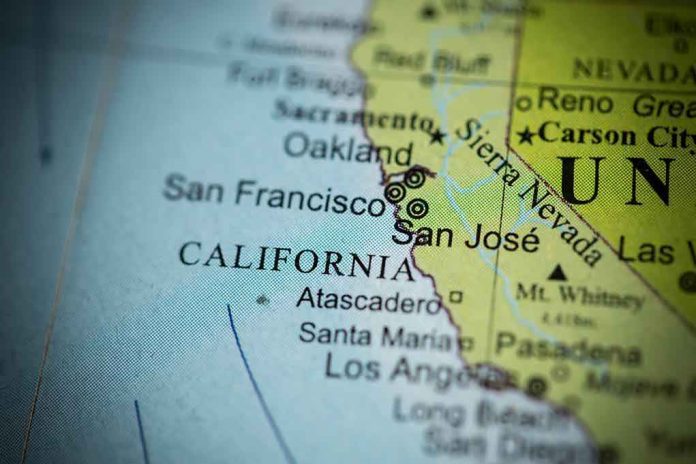
When anti-ICE protesters in San Francisco tried to block federal agents from detaining a man, they triggered a firestorm that rippled from city streets straight to the heart of the nation’s debate over law, order, and sovereignty.
At a Glance
- Anti-ICE activists in San Francisco attempted to prevent federal agents from detaining an individual, sparking chaos and legal confrontations.
- Trump administration’s aggressive immigration enforcement in 2025 has led to a surge in ICE operations and mass protests in major cities.
- Clashes between protesters and law enforcement have resulted in hundreds of arrests and the deployment of National Guard troops in Los Angeles.
- Federal and local authorities remain at odds, fueling tensions in sanctuary cities and raising questions about the limits of local resistance to federal mandates.
San Francisco Protest Erupts: A Clash of Agendas and Authority
On a recent afternoon in San Francisco, a group of anti-ICE activists took to the streets with bullhorns and banners, determined to stop Immigration and Customs Enforcement agents from detaining a man wanted for violating federal immigration laws. In a move that proved as unwise as it was dramatic, protesters attempted to physically block the agents, leading to a chaotic confrontation that quickly escalated. Video footage shows activists surrounding ICE vehicles, chanting slogans, and attempting to form a human shield around the target of the operation. The standoff ended as federal agents, backed by local police, pushed through the crowd and made the arrest—leaving at least two protesters in handcuffs and the rest with a harsh lesson in the consequences of obstructing federal law enforcement.
This spectacle wasn’t just another day in the city by the bay; it’s a microcosm of the larger ideological battle raging across America. The scene in San Francisco echoed similar protests in Los Angeles, where aggressive ICE raids have triggered days of unrest, vandalism, and hundreds of arrests. As federal and local authorities continue to butt heads, the question remains: how far can local resistance go before it crosses the line from civil disobedience to outright lawlessness?
Trump’s Crackdown: ICE Operations and the Rise of Resistance
Since President Trump’s return to the Oval Office in January 2025, the gloves have come off in the fight against illegal immigration. Within hours of his inauguration, the administration unleashed a wave of executive orders aimed at strengthening border security, ramping up ICE operations, and cracking down on sanctuary cities that refuse to cooperate with federal authorities. The Department of Homeland Security granted broad new powers to ICE, backed by reinforcements from other federal agencies, and even called in the National Guard where necessary.
Los Angeles—one of the nation’s largest sanctuary cities and a bastion of progressive activism—has become ground zero for the resulting chaos. In June, coordinated ICE raids swept across the city, targeting apparel businesses and migrant-heavy neighborhoods. Protesters flooded the streets, clashing with federal agents and local police. By nightfall, the LAPD declared an unlawful assembly. National Guard troops were deployed to restore order. Over 850 arrests later, the city’s leaders—like Mayor Karen Bass—condemned federal actions as “unacceptable” and “inhumane.” Yet for many Americans, this spectacle illustrates exactly why the country needs strong borders and clear laws: without them, anarchy reigns.
The Cost of Chaos: Who Pays for Political Grandstanding?
The fallout from these protests isn’t limited to broken windows and blocked traffic. Businesses in targeted areas are reporting losses as customers stay away and workers fear showing up. Immigrant families live in constant anxiety, unsure whether the next knock at the door will lead to separation or deportation. Meanwhile, law enforcement officers—federal, state, and local—are caught in a political crossfire, ordered to enforce laws that city officials openly oppose.
Local governments like Los Angeles have spent millions on overtime and riot control, while the federal government pours billions into border security and detention facilities. The recently approved House reconciliation bill earmarked another $12 billion for states supporting border enforcement, even as grants for programs aiding newly-arrived migrants are slashed. The message from Washington is clear: priorities have shifted, and those who obstruct federal immigration law will face consequences. Yet the left continues to demand more accommodations for those here illegally, as if taxpayer money grows on trees and American sovereignty is just a suggestion.
A Nation Divided: Constitutional Authority vs. Local Defiance
At the core of these clashes lies a fundamental question: who gets to decide how laws are enforced in America? The Constitution is clear—immigration is a federal responsibility. Yet sanctuary city officials, emboldened by activist pressure and leftist ideology, have declared open resistance to federal mandates. This is not civil rights-era civil disobedience; this is a calculated attempt to subvert the rule of law, undermine federal authority, and erode the very fabric of citizenship and national sovereignty.
Legal experts warn that mass protests and interference with law enforcement risk violating civil liberties and due process, but they also highlight the danger of allowing mob rule to dictate public policy. Political analysts see these events as deepening the partisan divide, with each side digging in their heels. For those who value law, order, and the Constitution, the spectacle in San Francisco and Los Angeles is a warning: if the rule of law collapses here, what’s next? How long before the rest of the country is forced to pay the price for the reckless grandstanding of a radical few?





